The Call of the Chengu
First published in Sanctuary Asia,
Vol. 38
No. 10,
October 2018
By Dr. Pia Sethi
A blue-grey silhouette of mountains shrouded in clouds in a darkening sky forms a surreal backdrop for a folk-dance performance in Kivikhu, a remote village in Nagaland. In the far distance chengu, the Great Barbet wails. Laughter mingles with the mellifluous voices of the women, and the roaring embers of a bonfire. I look around and see the tired but glowing faces of 16 ecotourists who braved Nagaland’s uncertain roads and perpetual downpours to support a small community conservation and biodiversity-based ecotourism initiative.
The enthusiasm is palpable. Despite hiccups, the last four days have brought many pleasurable moments and a bounty of butterflies and moths. The list includes over 170 species of butterflies including the stately nawab Charaxes dolon and the great nawab Charaxes eudamippus.
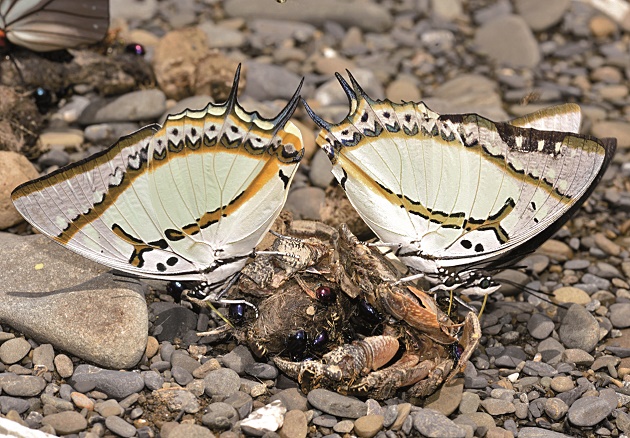 Along the banks of the Tizu river, a pair of great nawab butterflies absorb nutrients from a dung pile. Photo Courtesy: Sanjay Sondhi
Along the banks of the Tizu river, a pair of great nawab butterflies absorb nutrients from a dung pile. Photo Courtesy: Sanjay Sondhi
But for me, the most wondrous part of this evening, is the unstinted support of the local people who, despite reservations, whole-heartedly embraced this conservation adventure. And I am overjoyed to learn that the Tizu Biodiversity Conservation and Livelihood Network of three villages in Zunheboto district has just been recognised for their contribution to the sustainable use of biological resources under the Ministry of Environment, Forests and Climate Change (MoEFCC) 2018 Biodiversity Awards.
My mind wanders back four years to the start of our journey into the Sema tribal heartland of Zunheboto district. We had heard about the many little patches of protected forests dotting the Nagaland landscape, an informal network of community-conserved areas. We were keen to understand what motivated their creation, and how locals manage these forests. Luckily, the Nagaland Forest Department funded The Energy and Resources Institute (TERI), our organisation, to document Nagaland’s community-conserved areas, and to prepare the state’s first People’s Biodiversity Register for a village. I often wonder what prompted my colleague Siddharth Edake to traverse so far from Kohima and Dimapur over rivers of mud that pass off as roads to select Sukhai, a tiny remote village. Although I have cursed him many times for his choice, in retrospect, I do believe it was fate. The immediate reasons, however, were probably a combination of hunger pangs, a sumptuous meal provided by kind strangers and, of course, the stunning forests!
Nagaland presents a vista of spectacular hill forests and deep-flowing rivers. Unlike the western Himalaya, bird and mammal sightings along the way are few and far between. By the roadside, however, are stalls selling pineapples, the world’s hottest chilli, bhut jhalokia, plus an assortment of birds, frogs and mammals! We spotted rare ferret badgers, common palm civets, porcupines and Oriental Honey Buzzards, all dead and ready for the pot.
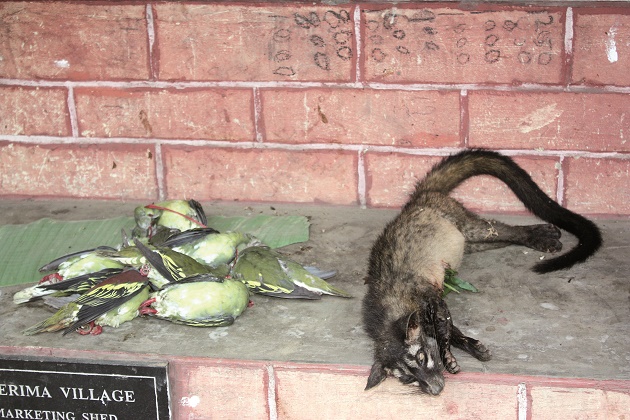 Hunting of wild animals for the pot is a largely cultural practice for Nagaland’s tribes. Once what was sustainable, is now putting pressure on the dwindling wildlife. Photo Courtesy: Yatish Lele
Hunting of wild animals for the pot is a largely cultural practice for Nagaland’s tribes. Once what was sustainable, is now putting pressure on the dwindling wildlife. Photo Courtesy: Yatish Lele
Hunting is a deep-rooted cultural practice intimately linked with agricultural traditions of shifting (jhum) cultivation. Unfortunately, sustainable hunting with traps and snares has made way for guns, while electric batteries supplant traditional practices to take a toll not only on fish, but other aquatic life too. Sadly, the long 30-year fallow period that allowed fields to regenerate back to forest have been replaced by shorter and shorter cycles of five to seven years.
Problems in Paradise
Almost one-third of Nagaland’s villages have created community-conserved areas (CCAs) in response to forest degradation, water scarcity, and dwindling wildlife. Our questionnaire surveys suggest that 74 per cent were initiated to arrest forest degradation and 65 per cent to address loss of wildlife. These steps were only possible because of prevailing land ownership patterns in Nagaland, where large swathes of forests are community or privately owned, and customary rights are protected under Article 371 A of the Indian Constitution. Moreover, the Nagaland Village and Area Council Act, (1978) grants Village Councils powers and duties to ‘supervise proper maintenance of forests’ and individuals, clans or village councils own almost 93 per cent of natural habitats.
While this sounds good, the ground reality is worrisome. Each CCA tends to be small, on average 500 ha., and isolated; few CCAs are networked across the landscape to form viable corridors for wildlife movement. Conservation measures imposed in these CCAs vary from restriction on felling to seasonal, species-specific or complete bans on hunting. But these are not always effectively implemented. Moreover, while such bans tend to be restricted to the CCAs, across the landscape hunting remains rampant and deeply entrenched. Understandably, this places Nagaland’s biodiversity in jeopardy in the long run. Clans and individuals own 72 per cent and 56 per cent of the land donated to CCAs respectively and this places long-term sustainability of conservation initiatives at risk because of significant, associated opportunity costs such as revenues from the sale of timber. Land-owners often want to capitalise on timber values as forests improve. Almost 81 per cent of CCAs face livelihood challenges and 59 per cent report incursions by the timber mafia. While these forests act as an informal network of protected forests, they have little policy or financial recognition from the government. Clearly, a solution to help sustain interest in community conservation is required.
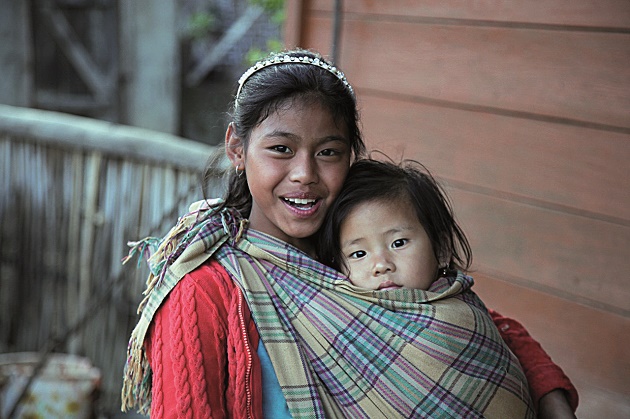 The author along with her colleagues at TERI began working with the Sema tribe of Nagaland to document and assess Community-Conserved Areas (CCAs). Photo Courtesy: Shireesh Joshi
The author along with her colleagues at TERI began working with the Sema tribe of Nagaland to document and assess Community-Conserved Areas (CCAs). Photo Courtesy: Shireesh Joshi
Problems forgotten, I soon find myself immersed in a Sema tribal world rich in folklore, biodiversity and traditional wisdom. I learn of the origin of myths and beliefs in lycanthropy, where individuals believe their souls are transmutated into those of the tiger. I also listen to fascinating tales of why a Crimson Sunbird’s neck is red and how the call of the chengu is a timekeeper of the Sema people.
I have an abiding fascination for the India’s Northeast. And with my colleagues – Siddharth Edake, Vidhu Kapur, Yatish Lele, I am deeply touched when Ivan Zhimomi, team leader, Tizu Biodiversity Conservation and Livelihood Network, the Gaon Burrahs and the people of Sukhai village request us to help strengthen community conservation across their ancestral village landscapes. We are supported by Conservation International – Japan through a Global Environment Facility (GEF)-Satoyama grant and work patiently and sensitively with the community to reduce hunting and fishing. Simultaneously, we train locals to document their biodiversity. Our goals are modest – stop hunting in the CCAs and control destructive fishing. But the people are ahead of us and want to stop hunting entirely and fine those who violate the self-imposed bans in the villages of Sukhai, Kivikhu and Ghukhuyi, which form the Tizu network, named after the river that unites their forests and people.
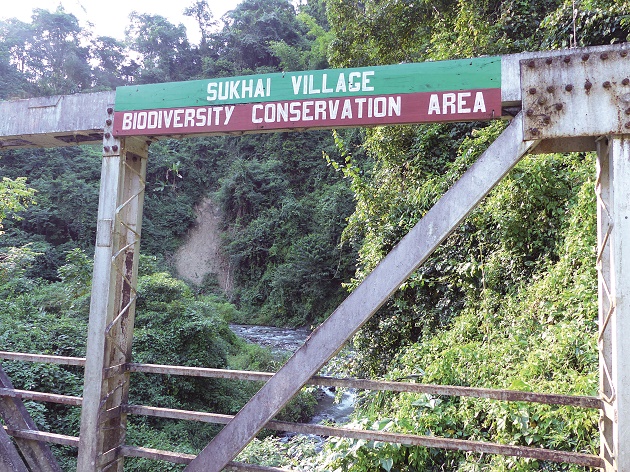 Nearly one-third of the state’s villages have established CCAs. The Great Barbet Psilopogon virens or the chengu is a symbol of the Nagas’ traditional affinity for wildlife. Photo Courtesy: Siddharth Edake
Nearly one-third of the state’s villages have established CCAs. The Great Barbet Psilopogon virens or the chengu is a symbol of the Nagas’ traditional affinity for wildlife. Photo Courtesy: Siddharth Edake
Tourism as Conservation
The next step is to train communities and develop low-footfall butterfly and bird tourism. Sanjay Sondhi of the Titli Trust comes on board and soon the local youth are pinging us on a WhatsApp group at all hours of the day and night with images of wildlife. Vihoto Kiba, turns into an avid photographer and is nicknamed Mr. Moth, and the ever-energetic Bokato Moru, a school teacher from Kivikhu, begins talking conservation in the neighbouring Chakesang villages of Phek district.
The initiative is supported by many who voluntarily give their time to visit the area. Binanda Hathibaruah, a bird guide and Ranjan Das, Sushil Chikane who plan to bring in groups interested in herpetology are supplemented by Dhananjai Mohan, a birder, and Alo, a local butterfly expert from Kohima. We do, of course, have the unstinted support of the Forest Department including Lokeshwara Rao, Panger Jamir, Temjen Yabang, and the DFO, Tokaho Kinimi.
The gains from a hunting ban become clear. We have recorded 212 species of birds including the endemic Naga Wren-babbler Spelaeornis chocolatinus and many equally interesting sightings such as the white-headed morph of the Himalayan Black Bulbul Hypsipetes leucocephalus and the Hodgson’s Frog mouth Batrachostomus hodgsoni. An unidentified squirrel, possibly a new subspecies, appears out of nowhere and is seen in virtually all the jhum fields, quite unafraid. The Mandarin trinket snake is also frequently sighted.
Perhaps the area is indeed on its way to recovery!
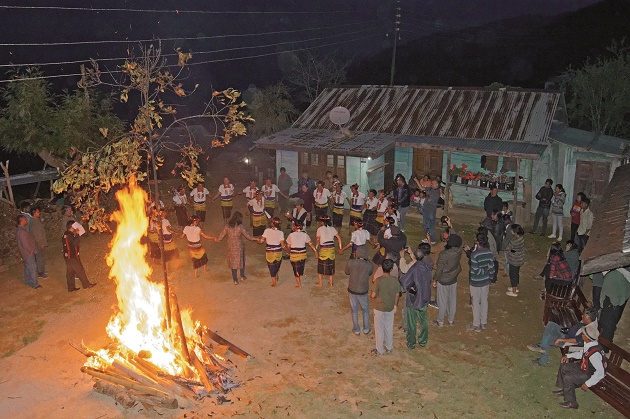 Locals in Kivikhu, a remote village in Nagaland, perform a folk dance for ecotourists, who have braved uncertain roads and perpetual downpours to support a small community conservation and biodiversity-based ecotourism initiative. Photo Courtesy: Shivakumar T
Locals in Kivikhu, a remote village in Nagaland, perform a folk dance for ecotourists, who have braved uncertain roads and perpetual downpours to support a small community conservation and biodiversity-based ecotourism initiative. Photo Courtesy: Shivakumar T
Yet, as the first ecotourists to this mountain world head back to Kohima, I worry about the sustainability of community-conservation in Zunheboto. As if on cue, three vehicles break down, and some of us are stranded by the roadside. Then the ‘tonk’ call of a nightjar pierces the night, and a star studded sky stretches its dome high above our heads. Hope for a sustainable future is once more restored.
Supporting Sustainable Tourism
The local communities need your support in myriad ways. You can simply visit the area and see many ‘specials’ amongst birds and butterflies. Or just come for the grandeur of the hills, the golden-hued jhum farm patches intermingling with greeny-blue forests and to meet the Sema community, traditional headhunters in years past with their unique dances and rituals. Join them in lighting a fire the traditional way or yoddle and dance during their Ahuna harvest festival. You can also visit the area to document the biodiversity, discover specials amongst birds and butterflies and perhaps new and interesting species and range extensions. Providing monetary support to fund one to two forest guards per month would also be greatly appreciated since the local communities receive no government support. Or you can even adopt a village. Share your knowledge or expertise – for example teaching ways to run a homestay, training in photography, waste disposal, fisheries development, marketing of produce or come help market ecotourism. Most of all come and appreciate the incredible conservation actions of the local people. Singers and musicians, come compose a song or a CD dedicated to community conservation.
And tourism companies and others promoting ecotourism in Northeast India, please visit, scope out the area and tie up with the local communities to bring ecotourists to Zunheboto, the heart of Nagaland. While we promise many ‘lifers’ for the ecotourists, in turn they will contribute to community conservation and enhanced forest protection.
How to Get There:
To reach Zunheboto, one has to travel to Dimapur by train or air. From Dimapur, hire a vehicle and spend the night at Kohima. It is recommended that one leaves early in the morning for the villages of Sukhai, Ghukhuyi or Kivikhu, which lie in the Satakha block of Zunheboto district.
Best time to visit: October to May.
Contact: Bokas Muru Email: bokatomuru@gmail.com,
Tel.: +91 9862681713 for information on homestays in these villages and travel arrangements. The villages are a treasure trove of butterflies and birds. For additional information on community conservation in the area, latest checklists and photographs, visit: nagalandcca.org and watch a documentary on conservation efforts by villagers at: Nagaland is Changing but...
Author: Dr. Pia Sethi


 Along the banks of the Tizu river, a pair of great nawab butterflies absorb nutrients from a dung pile. Photo Courtesy: Sanjay Sondhi
Along the banks of the Tizu river, a pair of great nawab butterflies absorb nutrients from a dung pile. Photo Courtesy: Sanjay Sondhi Hunting of wild animals for the pot is a largely cultural practice for Nagaland’s tribes. Once what was sustainable, is now putting pressure on the dwindling wildlife. Photo Courtesy: Yatish Lele
Hunting of wild animals for the pot is a largely cultural practice for Nagaland’s tribes. Once what was sustainable, is now putting pressure on the dwindling wildlife. Photo Courtesy: Yatish Lele The author along with her colleagues at TERI began working with the Sema tribe of Nagaland to document and assess Community-Conserved Areas (CCAs). Photo Courtesy: Shireesh Joshi
The author along with her colleagues at TERI began working with the Sema tribe of Nagaland to document and assess Community-Conserved Areas (CCAs). Photo Courtesy: Shireesh Joshi Nearly one-third of the state’s villages have established CCAs. The Great Barbet Psilopogon virens or the chengu is a symbol of the Nagas’ traditional affinity for wildlife. Photo Courtesy: Siddharth Edake
Nearly one-third of the state’s villages have established CCAs. The Great Barbet Psilopogon virens or the chengu is a symbol of the Nagas’ traditional affinity for wildlife. Photo Courtesy: Siddharth Edake Locals in Kivikhu, a remote village in Nagaland, perform a folk dance for ecotourists, who have braved uncertain roads and perpetual downpours to support a small community conservation and biodiversity-based ecotourism initiative. Photo Courtesy: Shivakumar T
Locals in Kivikhu, a remote village in Nagaland, perform a folk dance for ecotourists, who have braved uncertain roads and perpetual downpours to support a small community conservation and biodiversity-based ecotourism initiative. Photo Courtesy: Shivakumar T